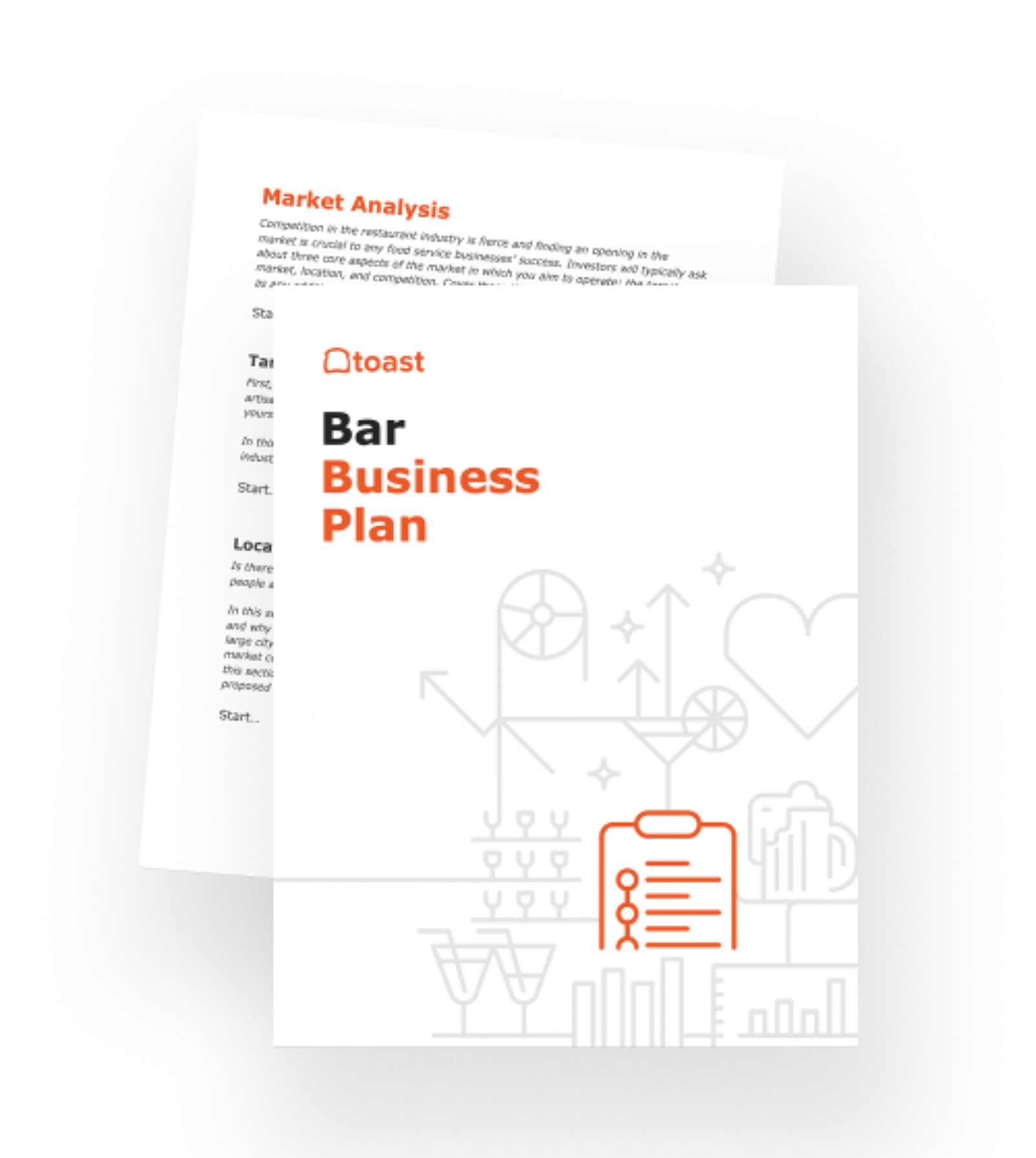Everything You Need to Understand Your Bar Financial Plan
Take control of your future bar’s financial plans with this guide.

Jim McCormickAuthor


Bar Business Plan Template
Use this free bar business plan template to easily create a great business plan that organizes your vision and helps you start, grow, or raise funding for your bar.
Get free downloadBuilding a bar business plan is an exciting time as you imagine all the creative ways that you’ll bring your vision to customers. The right financial planning is integral to the success of your bar.
This guide is a deep dive into all the necessary financial planning required to get an accurate picture of your bar’s profit and loss potential. And, it provides useful writing tips for making your bar’s financial plans a compelling read.
What is the Financial Plan?
Last but not least is epitomized in bar financial plans. As the final section of a business plan, a bar cost analysis details the specific investments, risks, and rewards that come with owning a business.
Investors want a breakdown of your business’s spending in the first year and a comparison of the costs to the bar’s revenue. This includes both fixed costs, like equipment, supplies, and loan payments, to variable costs such as payroll and marketing.
The financial section of your business plan will include different reports that give investors a detailed look at your business’s projected performance. That way, the risks and rewards of investment are clear. You’ll need a break-even analysis, investment plan, profit & loss statement, and cash flow statement.
How will the Bar Secure Funding?
Startup funds, whether in the form of savings, personal loans, or investments, are required to start a bar. Before getting into the specifics of your financial plans, consider the different avenues to securing funding.
First, it's important to know how much funding you need. Research the average costs of starting the kind of bar you envision. Don’t forget to consider contingencies–it's smart to secure enough funding to support the bar for the long haul. Then, you can think about how you can access those funds, such as:
Personal Loans
Loans from private investors
Friends or family funds
Merchant cash advances
Small business administration (SBA) loans
Commercial real estate loans
Equipment Financing
Purchase order financing
Investors will also want to know the terms of their investment. Detail how you plan to repay loans and what return-on-investment early partners in the business can expect.
How will the Bar Break Even?
Breaking-even describes the month when your bar’s monthly expenses are less than its income. It can take anywhere from 6 months to several years for bars to break even, depending on the business model.
Break-Even Analysis
A break-even analysis is pretty simple–compare your projected revenue against your monthly expenses. You’ll have to engage in some informed estimation to determine sales projections. But, you should be able to get an accurate view of fixed expenses and a range of variable expenses before you open your doors. That way, you can tell your investors how long you can operate before becoming profitable, e.g. how long they can expect before seeing returns on investment.
How can you make Financial Projections?
There are a few different reports that investors will expect to be in every bar business plan.
Investment Plan
In this section, explain how the initial investment you hope to receive will be spent in the first year. Include detailed expense plans for equipment, furniture and decor, payroll, legal fees, marketing, and contingency funds.
Projected Profit and Loss (P&L) Statement
Even without sales data, you can create a projected profit and loss statement for your bar’s business plan following. Also called income statements or cash flow statements, a profit and loss statement will be useful throughout the life of your business. It helps you to measure the financial health of the business and calculate your bar’s revenue.
Rather than starting with a timeframe, start to project your bar’s expenses and income by balancing the cost of goods sold against labor, operating costs, and occupancy costs like rent and insurance.
Accurately calculating food costs for your menu items is crucial–that way, as you project sales over time, you are getting an accurate idea of the costs and profits from those sales. Prime costs refer to the cost of food, labor, and supplies that go into each dish.
Operating costs are the expenses involved in day-to-day operations that are usually easy to control once the bar gets up and running. But, budgeting for supplies, repairs, and marketing can be tricky. Market research will help you to estimate operating costs accurately.
Occupancy costs, such as rent or mortgage, loan repayments, and insurance are fixed overhead costs. As you create a projected profit and loss statement, these costs will inform the sales and profits that are needed to keep the business running.
Finally, after researching and projecting expenses, you’re ready to think about a timeline for your profit and loss statement. Think about the location and market as you calculate sales projections over time. For instance, if your town has a lot of tourism in the summer, you can expect higher sales for those months. But, maybe the same town shuts down for the winter–how will your peaks in sales balance the expenses of the slower seasons?
Repeat the process for each month of operations, projecting sales based on key performance indicators like the season, marketing, and the habits of local customers. Eventually, you’ll project a month where your sales outpace your spending–the result is a timeline to breaking even.
Writing your Bar’s Financial Plans
Writing about finances can be a challenge–here’s how you can make the details of your bar’s finances an interesting read.
Always keep the audience in mind. Use some of the financial vocabulary introduced in this article and write for your potential investors.
Find your voice. This is YOUR business plan, after all, so remember to balance your unique style of writing (or speaking) with what your audience needs to hear.
Keep it simple and clear. It's tempting to throw in lots of clever flourishes when writing, but clarity should be the number 1 priority when discussing the financial details of the business.
Is this article helpful?
DISCLAIMER: This information is provided for general informational purposes only, and publication does not constitute an endorsement. Toast does not warrant the accuracy or completeness of any information, text, graphics, links, or other items contained within this content. Toast does not guarantee you will achieve any specific results if you follow any advice herein. It may be advisable for you to consult with a professional such as a lawyer, accountant, or business advisor for advice specific to your situation.
Read More
Subscribe to On the Line
Sign up to get industry intel, advice, tools, and honest takes from real people tackling their restaurants’ greatest challenges.


